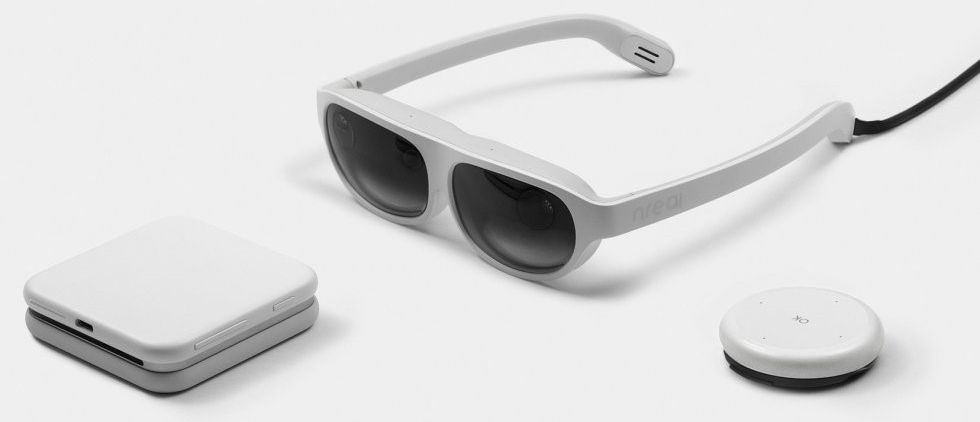Mixed reality technology start-up Nreal Technology Co., Ltd (Beijing, China) provided a preview of its AR glasses at the recent CES show in Las Vegas.

Perhaps the most memorable impression and a particular selling point for the Nreal AR glasses is the opinion that their look is quite appealing – both in absolute terms and in comparison to other prototype and commercially available AR glasses. The Nreal AR glasses system is demonstrated in the video appended to the end of this article as well as pictured in the figure below.
 Left: the processor pack. Center: the Nreal AR glasses. Right: the wireless motion controller.
Left: the processor pack. Center: the Nreal AR glasses. Right: the wireless motion controller.
Part of the means that enabled Nreal to produce AR glasses that are slim and that weigh just 85 grams was accomplished by putting much of the device electronics and the power source in a separate processor pack. The pack is connected to the AR glasses by a cable. The processor pack is itself physically compact and capable of fitting into the user’s pocket. The motion controller for Nreal’s AR glasses is a small disk that can be magnetically attached to the processor pack. The motion controller communicates wirelessly with the processor pack. The processor pack and the motion controller are also illustrated in the figure above.
It is intended that the user’s smartphone be attached to the processor pack. The means of connection is a USB-C cable which, in turn, means that the smartphone is able to provide power to the processor pack and the AR glasses. Nreal notes, however, that, at this time, the system is set up to work only with Samsung smartphones. It is unclear if and when it will be possible to use the processor pack with smartphones made by other companies.
An image is produced in both lenses of the AR glasses. Each image has a resolution of 1080p and the glasses have a 52º field of view. Other features of the Nreal AR glasses include the following:
- A Qualcomm Snapdragon 845 mobile processor.
- 360º spatial sound through two speakers.
- Built in microphones to enable future voice control and smart assistants.
The AR glasses also include other sensors for providing full 3D movement through the 3D environment. That is, the sensors maps six degrees of freedom. Note, however, that the wireless motion controller map only three degrees of freedom. One consequence of this is a somewhat reduced ability to recognize hand gestures.
There are two cameras on the front of the AR glasses. These are used to implement Simultaneous Localization And Mapping. SLAM is a computer vision technique that enables AR headsets to map the surrounding environment and to track objects as they move through this environment.
Commenting on the demonstrations at CES, one on line reviewer reported “incredibly crisp visuals,” and that the “wide FOV makes a huge difference.” He went on to comment that, “the glasses might have some trouble doing real-time mapping and object recognition at the same level of sophistication as Magic Leap.”
The AR glasses are scheduled to ship sometime during the third quarter of this year. The price is likely to be under $1,000.
As a separate but related matter, Nreal just announced that it has raised $15 million in total funding to date. – Arthur Berman
Analyst Comment
I got the chance to look at the Nreal glasses at one of the evening events at CES. The glasses use MicroOLEDs as imagers and have the displays above the lenses, with beamsplitters to deflect light from the displays into the eyes, which means that the glasses are a bit bulkier than they seem to be when viewed from the front, although the image quality is quite good. The company told us that it is developing a version of the glasses for professional applications. The controller ‘puck’ looks neat and the detachable controller seems an elegant solution. (BR)
 Image:Meko
Image:Meko

